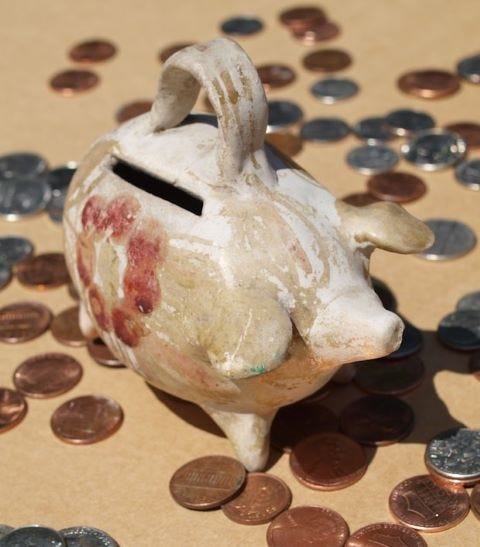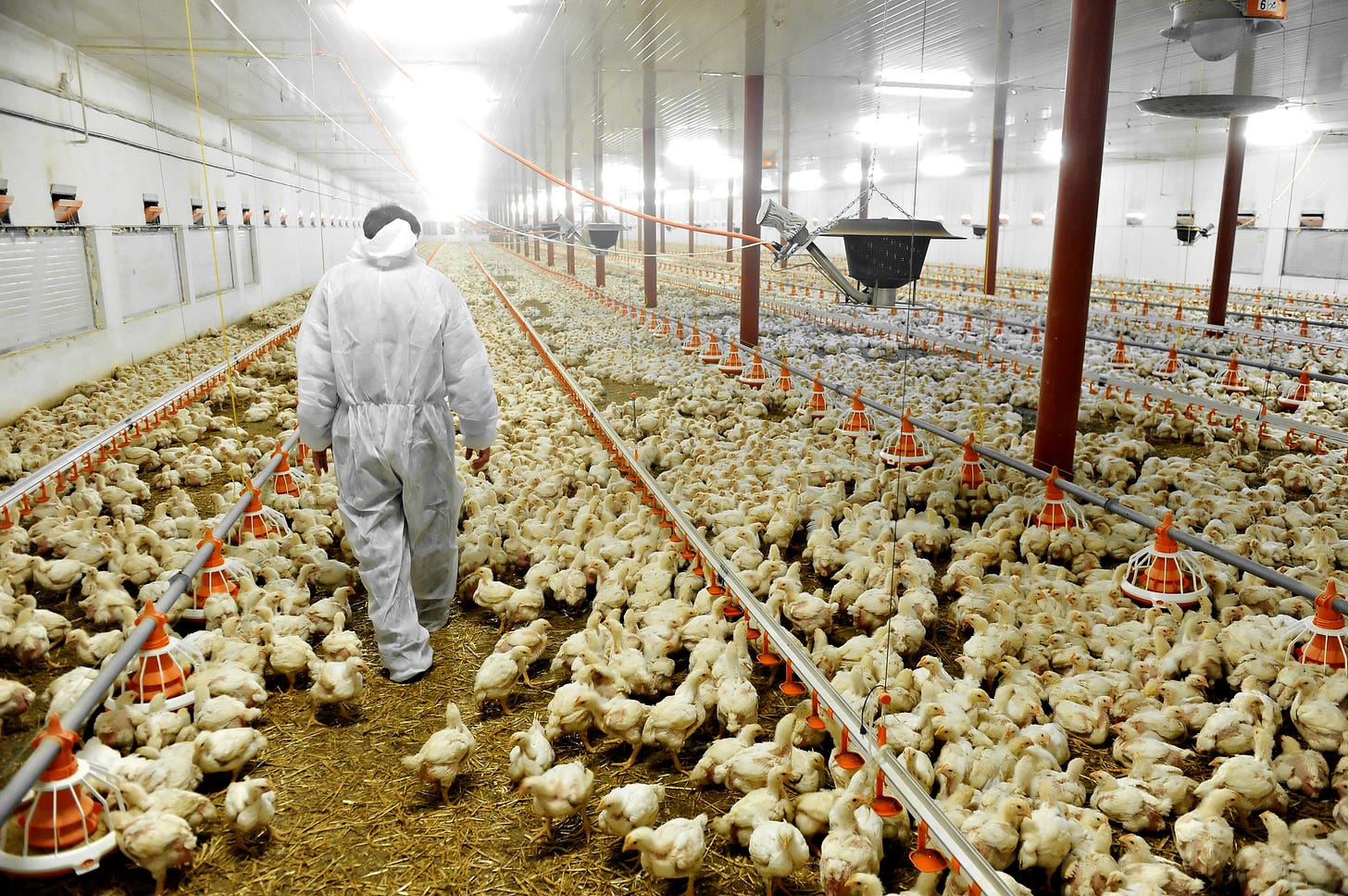Every edition features 7 stories, from the past week. I’ll draw on my background in media, journalism, agriculture, biotech, and renewable energy to come up with an interesting selection and do my best to offer some context.
Sometimes built around a theme, sometimes random, but with a Canadian twist.
The United States Department of Agriculture announced this week that avian flu has been found in US dairy cows for the first time. This comes 10 days after a goat in Minnesota tested positive making it the first known livestock infection in the US. The dairy cattle infections are in Texas and Kansas, but there are presumptive positive cases (meaning it requires further lab tests before being confirmed) in New Mexico and Idaho. Symptoms in dairy cows include a drop in milk production, loss of appetite, and a low-grade fever. Pasteurization kills the virus so any milk that made it into the consumer food supply before the infection was discovered is safe.
What is concerning about these cases is not only has avian flu appeared in mammals, but there is an increasing risk of crossover to people. The Texas Department of State Health Services reported this week that a person who had direct contact with dairy cattle presumed to be infected with avian flu has shown mild symptoms of the infection. This is the second human case of the H5N1 virus. The Canadian Food Inspection Agency says it is aware of the US cases but has not detected avian flu in dairy cattle or other livestock n this country. Avian flu however is common in Canada so in March the US imposed import restrictions on “certain avian commodities”. CBC’s Senior Health & Medical Reporter addresses the question of where is it headed next?
When detected early, colorectal cancer can be effectively treated but it remains the fourth most common type of cancer. In general, rates are decreasing in Canada except in people under 50 years of age where the rates are increasing. In the case of those 44 or younger the rate has almost doubled. This could be due to lifestyles with a higher risk factor such as more processed and fatty foods, alcohol consumption, and obesity. Younger adults are also more likely to be diagnosed at a later stage which coupled with higher risk makes early and regular testing important. The Canadian experience is the same as in the US where the New York Times reported last week that “More Young People Than Ever Will Get Colorectal Cancer This Year”. If you are in a higher risk group you should be aware of the first signs of the disease and no matter what your risk factor or age, be sure to get tested regularly.
Plastics can be either petroleum-based or plant-based. Some are biodegradable and will decompose eventually by natural means. Others are compostable meaning they can be processed in an industrial composting facility. And the rest stick around forever. All these plastics release at least some microplastics which are ingested by marine life. And by mammals, including you and me. Some research suggests that the average person ends up ingesting 5g of these microplastics every week.
Researchers have been hard at work developing alternatives to plastics and in finding ways to at least limit the release of microplastics and speed up the time it takes for them to degrade. Researchers at the University of Portsmouth, England and the Flanders Marine Institute, Belgium, said this week that a new bio-based plastic material held up better than conventional plastic when exposed to seawater and sunlight and therefore released less microplastic. In late March, University of California San Diego and materials-science company Algenesis said that their plant-based polymers biodegrade in under seven months.
Though it is good news in dealing with the many challenges around plastic, neither team eliminated microplastics. The only real solution is to reduce our use of plastic and keep the stuff out of oceans, waterways, and the food chain.
The just transition for workers into clean tech can be contentious and the ‘let’ s go green team’ does not help itself sometimes. The latest example comes for a story in the National Observer which said that 87% of Canadians surveyed in a new poll commissioned by the not-for-profit organization Iron & Earth, agreed that climate change needs to be addressed. Even better news was that among federal Conservative voters there was an acknowledgment that Canada is feeling the impact of climate change. Those Conservatives support a shift to renewable energy.
However, the National Observer article raises some questions because of what it does not say. (Full disclosure, I am the former Director of External Relations for Iron & Earth.) The story referred to a 2021 Iron & Earth Abacus Poll where 60% of workers worried about being left behind in the energy transition and 68% worried about losing their jobs. Also at the time of that poll, more than three quarters of the respondents indicated they would be willing to participate in retraining to become part of the new renewable energy economy. This latest survey shows that only 40% of workers now have similar concerns. It would be interesting to see what else the new poll says but the National Observer story offers no further detail nor is there anything on the Iron & Earth website at the time of this writing. So what happened? What I can say from experience is that there was very little pull from workers wanting to transition during my time with the organization. Even with $16 million in funding through the Federal Sectoral Workforce Solutions Program starting in late 2022, Iron & Earth was not coming close to meeting its deliverables. Part of that was due to a loss of focus on the organizational mandate, but with little support or co-ordination across like minded not-for-profits or from workers, the funded program was destined to fail. In all, 7 organizations received more than $111 in funding to “to support over 22,270 Canadians and benefit approximately 970 employers across the country” and as far as public facing information goes, the funding did not move the just transition needle. That $111 million funding envelope came to an end on March 31st and if anyone is interested in partnering to determine how it helped the just transition, let me know. The transition to renewables is a good idea, but throwing money at the idea and hoping it will stick, is not an answer.
On April 1st, 1999, Nunavut officially became a territory, when it separated from the Northwest Territories, making 2024 its 25th anniversary. The territory is huge. 2 million square kilometres (about 770,000 square miles) all north of the treeline. Home to the longest coastline in Canada thanks to the Arctic Archipelago. It has an incredible diversity of wildlife that are not bothered by too much road traffic because there are no roads outside local communities. And there are no territorial political parties. Instead Members of the Legislative Assembly run as independents and govern by consensus.
Becoming Nunavut was not easy. The idea began in the 1950s, a bill to split the Northwest Territories died on the order paper in 1963, while plebiscites and votes by residents in favour of the creation of the territory kept the idea alive. Finally in 1993 the Nunavut Land Claims Agreement (more commonly known as the Nunavut Act) was enacted. This makes it the youngest member of Canada’s Confederation and it is also the youngest demographically. CBC has a story on the generation turning 25 as the territory celebrates its own anniversary.
To all those turning 25 this year – Happy Anniversary!
Are Canadian Piggybanks Facing Extinction - Or Are They Just Temporarily Collecting Dust?
When the H & R news release popped up on my news feed I saw a couple of ways to examine the headline and I’ll offer some quick insight into both. I’ll start with the one that got my curiosity going first. Piggybanks in the age of tap or app to pay?! In early agrarian societies, pigs were a cash cow. 😉 A piglet could be fed scraps from the dinner table and low-cost feed starting in the spring, and fattened up in time to be butchered to ensure food for the winter. 2 pigs? One for home use and one for the market. Hence the rise of the “piggy bank” because it was fattened up until fall, then opened up (or smashed depending on the piggy bank) when needed. Are they still used in our digital age? You bet. You can find them on Pottery Barn, Etsy, Wayfair, Amazon, or just about any other site where you do your household shopping. eBay has vintage piggy banks and Bargain John’s Antiques has a cast iron piggybank for $295.00 (USd).
Now to the more serious side of the H & R survey which found that less than a third of Canadians put away savings every month and 75% are concerned about their lack of savings. The result? Living paycheque to paycheque is fast becoming the norm. With the high cost of just getting by, a CIBC poll in February found that those who can put something aside on a regular basis are going for liquidity ad predictability over aggressive growth.

Which brings us back (again) to inflation news. It is the stuff of headlines, protests, and election issues. The common theme tends to be that any given province, state, or country is experiencing the worst inflation and finger pointing ensues.
Time for a quick reality check.
Trading Economics tracks inflation around the world and posts the latest rates. Every country in the world is experiencing inflation to some extent with the notable exception of China which is in a negative state of deflation. At the other end of the spectrum is Argentina coming in at an eye-watering 276%. The United States sits at 3.2% and Canada at 2.8%. In a globally connected economy, it is impossible to escape at least some measure of inflation. The ripple effects of supply chain disruptions such as the war in Ukraine, attacks on shipping in the Red Sea, cuts to Panama Canal traffic, and even the recent bridge collapse in Baltimore are woven into the global economy. Supply and demand influence energy price and is generally out of the control of any single country. Globally, climate change affects crops and puts pressure on costs associated with climate mitigation as outlined in the latest Climate One podcast.
Consider the consumer items that are used to calculate inflation:
Food – You need to work hard to fill your shopping cart with only grown in Canada products for your dinner table. As a result, global factors have a significant impact on what you are eating.
Shelter – Local and regional factors weigh heavily on the cost of keeping a roof over your head, but construction materials vary widely in where they come from and the route to the job site.
Furniture – Probably a mix in your household, but my guess is that your favourite chair and your bed came from at least outside your province, if not from outside Canada.
Clothing – Good luck in ensuring that everything you are wearing through 4 seasons is made in Canada from Canadian fabrics and therefore less prone to global prices fluctuations.
Transportation – Your vehicle may well have been assembled in Canada, but the parts are imported from around the world. And sorry, there is no made in Alberta, made in Canada, or even made in North America price for gasoline. It is a huge mix of global factors.
Recreation – Have you already forgotten how hard it was to find a new tire for your old bike, let alone a brand-new bicycle during the pandemic? Everything is connected so somewhere else.
Next time you are ready to single out a company, government or politician as an inflation instigator, think of the bigger picture. Or just read this article from the Guardian on “How a viral $22 burrito explains inflation in the US”.
Read, comment, subscribe, and share this newsletter.
I’m available for contract and freelance work with not-for-profits and charities. With 40 years of experience behind me and lots of time ahead of me, I’m here to help you make a difference in your media relations, public relations, and general communications needs.



